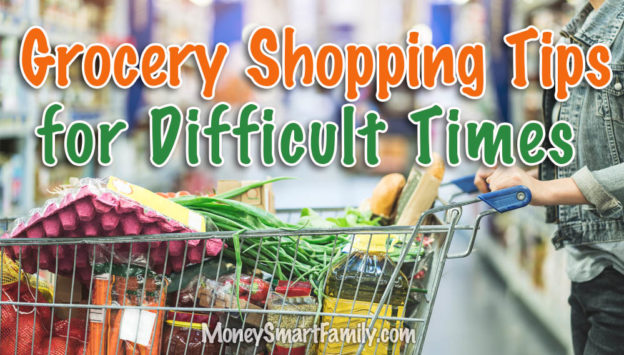Have you been affected by grocery panic buying?
The worldwide virus has created upheaval and overload on our medical community and economy. Panic buying has hit the grocery stores and as a result, your grocery strategies will need to change.
We’re sharing multiple grocery strategies to help you survive a Flu Pandemic and Panic Buying. We’ll also help you with Stocking Up and Emergency Preparedness.
During this time of uncertainty, there will be hoarding, supply chain disruptions, fear, and shortages … in the short term.
But if most of us can stay calm and realize that your local grocer will not run out of food, we’ll come through this just fine.
With so much uncertainty and change, it is going to take a long time for food prices and stock levels to return to pre-Covid-19 levels. And, of course, there is that possibility that things will never return to where they were.
The biggest issues for the level-headed thinkers are:
- How will your shopping habits change?
- When is the best time for you to shop?
- Where can you find high demand items?
- What should you stock up on?
You may experience shortages on some items as stores use up their top stock. There will be distribution shortages as store warehouses also run low due to high demand and disrupted deliveries.
But if you look for alternative stores, substitute other items, shop smarter, and wait patiently you’ll get all that you need.
Here are the strategies that we’re using today to keep our pantry and freezer stocked.
TABLE OF CONTENTS
- 1 1. Realize Things Will Be In Stock Soon
- 2 2. Store Ads
- 3 3. Purchase Limits & Returns
- 4 4. Unfamiliar Grocery Items
- 5 5. Learn to Time the Trucks
- 6 6. Shopping Behavior
- 7 7. Senior Shopping Times and New Store Hours
- 8 8. Alternative Stores for Groceries
- 9 9. Minimize Meat and Maximize Produce
- 10 10. Take Stock: Inventory Pantry & Freezer
- 11 11. Search for New Recipes
- 12 12. Cookbooks
- 13 13. Grow Your Own Food
- 14 14. Canvas Bags
- 15 Pandemic Groceries Conclusion
1. Realize Things Will Be In Stock Soon
Annette predicted that the store shelves would start to fill up about 4 weeks after the initial panic started.
And that’s exactly what we are seeing. Some of the stores are saying that they are only getting 30 to 50 percent of the things they ordered.
But many folks have hoarded so much food in their panic buying that they’re slowing down their purchases now.
This increased stocking up has Annette wondering if these hoarders really know how much food they need for a 4 to 8 weeks spread.
2. Store Ads
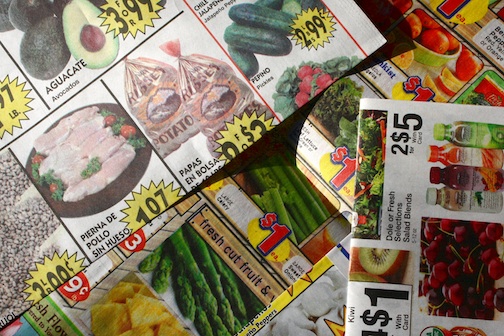
We’re finally starting to receive store ads in the mail, but not all grocers are represented. In the past, each week we would usually receive grocery flyers in the mail for all of the grocery store chains in our area.
But since the Shelter-At-Home directive hit, we’ve received none of the store ads for several weeks.
We checked and the stores are still publishing them online, but they are not being distributed via snail mail.
Interestingly, two of the 8 chains in our area are still putting out ads. But some of the time, these stores don’t have the ad items in stock. And the stores are not giving rain checks at this time.
This is NOT the time to stock up on a ton of extra food folks.
Store Coupons
We’ve also not seen any “shocker” store coupons in the store ads. In the past, we’d regularly see special store coupons for things like 99 cent butter or 74 cent coffee creamer, usually with a limit of two.
Safeway was known to release at least two “shocker” coupons each week as an incentive to get customers into the store. These have vanished.
The stores don’t need them. Folks are shopping like mad.
Loss Leaders
There will be very few “loss-leader” items in the ads right now. Loss-leaders are grocery items that stores are willing to take a loss on to entice you to shop at their store. They count on impulse buys, which are so normal, and the purchase of other items to make up for the loss on one particular item.
Rising Prices
Prices have also risen on many products. Some slightly and others a lot.
Here are a couple of examples:
Eggs:
- Before Panic Buying, we’d see a sale price of 99 cents per dozen
- Now: $2.99 per dozen
Whole Chickens
- Before Panic Buying, we’d see a sale price of 49 cents per pound.
- Now: $.99 per pound is the lowest we’ve seen.
We don’t think it’s price gouging, but from what we’ve read and learned from store employees, manufacturers are having a hard time keeping up with some of the demand. As a result, there are shortages at the grocery store for things like toilet paper, tissues, canned soups, rice, pasta, and more.
Food Service Production
We’ve also learned that the closure of restaurants did put reduced demands on suppliers. But in most cases, those supply chains were completely separate from the retail grocer side.
Consequently, manufacturers have had to reduce bulk production, but in many cases, they haven’t been able to allocate excess products to the retail side.
One major example is the dairy industry. Dairy farmers have resorted to dumping milk produced for Food Service purposes because of the low demand. According to the NY Times, some egg producers and some vegetable farmers are facing the same plight.
3. Purchase Limits & Returns
Due to shortages and hoarding, stores have put purchase limits on many items. Please respect these limits so that others can get what they need. If you do need to stock up, you may need to make a few trips in a week to get the amount you need.
We know this is a pain in the neck, but please think about those with large families or the elderly who can’t get out very often. We’ve got to all work together and think about others at this time.
Also realize that many stores have instituted a no-return policy, not only on food items, but also paper goods and other items. This means if you buy too much or any particular item you’ll need to use it up, share it, or give it away.
4. Unfamiliar Grocery Items
Don’t buy food items you have never or rarely eaten before. One family we know stocked up on canned vegetables, just in case there was a food shortage. This is despite the fact that they have never eaten them before. We predict that their canned food cache will either be donated to a food bank or thrown away in six months.
We have always kept a stock of canned vegetables in our pantry. They are used to replace fresh veggies if we’re running low at the end of the month. But, Annette tracks them and uses them up when they get close to expiration. She mostly adds them to a big pot of soup in the wintertime.
If you have purchased food you won’t really eat, please be sure to donate it, rather than throwing it away when life gets back to normal. Just search for “Food Bank near me” and you’ll know what the options are in your area. We have a favorite food pantry where we make donations several times each year. They truly appreciate any help from the community that they can get.
5. Learn to Time the Trucks
Each store will have a different day and time that their trucks deliver new goods to the store. Chat with store employees to get information about when a truck with your needed items is expected.
We talked with a Smart & Final employee (small warehouse club in the Southwest USA) who told us that their meat truck surprisingly had not yet arrived this particular day. They went on to tell us that during the flu pandemic Shelter-At Home restrictions they have been receiving about 30 percent of what they requested.
We had a discussion with a national drugstore chain employee who told us that their truck arrived every Thursday morning.
Several different stores employees told us that they will typically run out of high-demand items by noon on delivery day.
When quantities are limited, getting your timing right and showing up early will get you what you need.
- Grocery Delivery Services
Using Instacart and other grocery delivery services could be a good way to avoid possible infections from shopping. It’s also a great way to save time and gas.
However, during this pandemic time we’ve had many folks tell us that having groceries delivered has been frustrating. Since many stores have so little stock of many items orders are arriving ½ filled. As a result, consumers are not receiving the items they desperately need.
6. Shopping Behavior
We’ve seen videos of shoppers violating purchase limits. Also, other shoppers getting so desperate for items that grabbing, pushing, and shoving occurred. We are going to get through this. We all need some patience and kindness.
There will be some people who will behave badly. We are happy to say that we have not experienced or seen any of this. Remember your manners and be patient, you’ll eventually get what you need.
Especially don’t hassle store employees, they’re doing the best they can in unbelievably stressful situations. And they’re taking lots of risks by working and exposing themselves to hoards of people. We did talk to one store employee who told us one customer had actually grabbed food items right out of their hands!
Remember, it’s not their fault that distributors don’t have the products for their store or that people are hoarding.
What should you do if you are desperate for an item and the shelves are empty AND you see another customer with several of those items in their cart?
Just ask nicely if they would be willing to share one with you. Please respect their wishes. Being polite and respectful may help you get what you need.
By the same token, if you come across an abundance of a needed item, buy a few extra (if limits allow). These can be shared with shut-in neighbors or with your family and friends (don’t hoard … leave some for others).
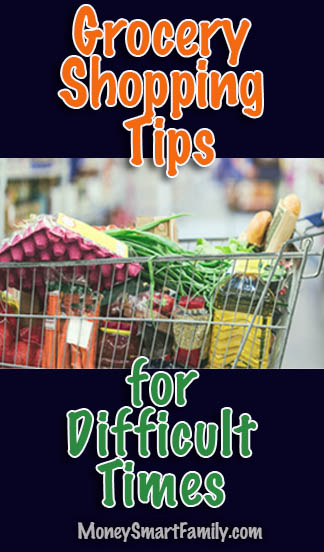
7. Senior Shopping Times and New Store Hours
Many grocery stores have set aside early morning shopping time for seniors or those with compromised immune systems. The strange thing is that these dedicated times attract lots of customers.
Steve & Annette were in the store one morning between 9:30 am and 10:30 am and it was like a ghost town. So don’t assume that early store hours are the best and safest time for you to shop.
Remember that many stores have decreased store hours. They are opening later and closing earlier. It’s best to call ahead or go to their website to confirm their hours of operation.
8. Alternative Stores for Groceries
Be sure to check out stores that are not primarily grocery stores. Places like 99¢ Store, DollarTree, and BigLots. In Arizona and on the West Coast, Smart & Final, a smaller warehouse club and restaurant supply store is one of our favorites. They don’t charge a membership fee AND they usually aren’t are crowded as a grocery store.
A friend recently mentioned that they could not find flour at any grocery store. However, she found a huge bag at an Asian Market and divided it amongst friends. We’ve seen these bulk bags of flour, rice, and beans at some warehouse clubs also. Buying large quantities and sharing among family and friends works great.
Because many folks are cooking and baking at home as they self-quarantine, finding flour has been more difficult.
RELATED ARTICLE: Grocery Stores with Senior Discounts
9. Minimize Meat and Maximize Produce
Since certain cuts of meat as well as side dishes like rice and pasta are either hard to find or more expensive now. Learn to stretch your meals by adding produce.
The produce sections of the grocery stores seem to be well-stocked. And everyone knows we should be eating more fruits and veggies anyway.
Vinegar Rinse – Acidic
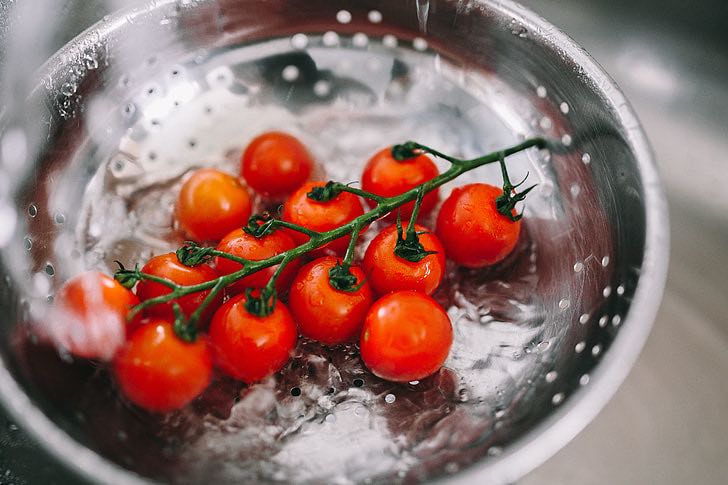
To make your produce last longer, bring it home and wash it in your sink. We use one-gallon of water with one cup of apple cider vinegar added to it.
We have a nurse friend who confirmed that diluted apple cider vinegar rinse will kill some mold and bacteria. Rinsing with water afterward will also remove some pesticides.
Meredith Olson, Ph.D. Engineering, Massachusetts Institute of Technology on Quora said,
“White vinegar (containing about 5% acetic acid) is acidic enough to kill a majority of mold spores, so it can help to reduce the likelihood of mold growth. It is known to have a bactericidal effect on foodborne pathogenic bacteria, such as E. coli or salmonella.
However, diluting with water will naturally reduce the acidic percentage of the solution and may not be as effective. In addition, some bacteria are killed more quickly than others.”
Baking Soda Rinse – Alkaline
However, daughter Becky found that using a rinse of water and baking soda which creates an alkaline environment rather than an acidic one, will work better at killing bacteria, viruses, and fungi.
This method was proven effective in a research study by the University of Massachusetts in Amherst. Dr. Lili headed a group study to determine the more effective method of removing pesticide residue from apples.
They compared soaking fruit in diluted Clorox bleach and water and baking soda. The study, which was summarized by Reuters, determined that the baking soda and water rinse was much more effective.
Rinse Well
Regardless of which germ and pesticide removing method you use, rinse well with cool water and dry before storing your fruits and veggies.
10. Take Stock: Inventory Pantry & Freezer
This is a critical step to knowing what you truly need to purchase. It is also a great project to have your kids help with.
An accurate inventory will help you to include forgotten items into your menu planning. And it will provide a great opportunity to expand repertoire by searching for recipes to use up those odd or less appetizing items.
We have an entire article on how to inventory your freezer and pantry. There is also a free freezer inventory worksheet on that page. Or you can pick up a copy of our book, “Cut Your Grocery Bill in Half.” It has an entire chapter devoted to keeping your food organized.
Start your inventory by taking as much as you can out of your freezer and pantry.
When you’ve completed your inventory, use boxes or plastic baskets on your pantry shelves and in cabinets to organize similar items together. This will help you to be more efficient in using up what you have.
In our chest freezer, we use canvas tote bags to keep similar items together.
11. Search for New Recipes
Adding variety to your menu will make a homestay much more enjoyable. It will also help you to use up those newly discovered items from your inventory list.
Annette’s favorite source for finding new recipes is Pinterest. She has put together numerous boards with recipes she has discovered and tried. Check out our Pinterest page here.
Or review tons of money-saving meals in our Recipes Section.
12. Cookbooks
Every household should have at least 3 all-purpose cookbooks. This is especially helpful if your internet connection goes down.
Annette’s favorites are:
- Good Housekeeping Illustrated Cookbook
- Betty Crocker Cookbook (orange cover)
- Better Homes & Gardens Cookbook (red & white checks)
You can read more about them and get links to buy used ones on our Cookbook Reviews page.
13. Grow Your Own Food
Just like families did during WWII food rationing, growing a “Victory Garden” could be a good idea. Gardening is rewarding and “fruitful.”
If you are able and have space you should consider putting in a garden or at the very least, doing some container gardening. Things like herbs, veggies, and other edible items can be grown in pots or worked into your landscape design.
Our daughter Becky and husband Nolan live in a 2 bedroom, 3rd-floor apartment. Becky has transformed their balcony into a food-producing garden that looks amazing every time we go to visit.

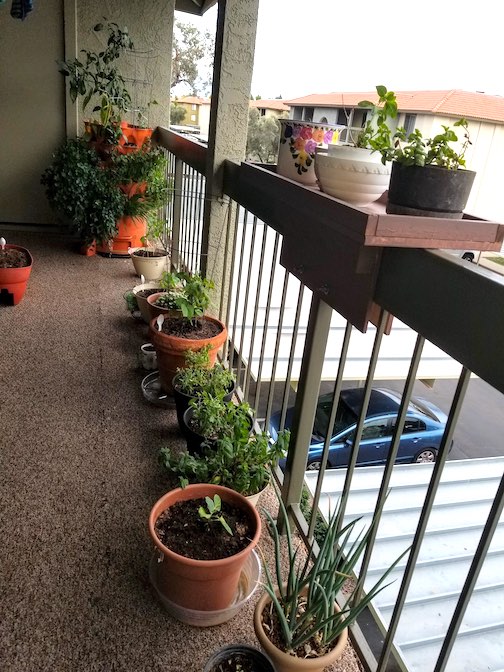
We spoke at a family conference in Ohio where a woman shared that she hadn’t been out to her garden in a couple of weeks. It rained so much in her area that all that was required for growing food was the initial set up, some weeding, and then harvesting.
In Arizona, where we live, if you want to keep your garden alive in June, July and August, you’ve got to water it and watch it every day. If you skip a day, your garden will be dead.
If you’re new to gardening and in a different climate than you’re previously experienced, consider joining a local Facebook gardening group.
We’ve been pleasantly surprised by the willingness of gardeners to share their knowledge about soil, plants, watering, and more. They’ve also shared their experience and resources.
And best of all there are lots of opportunities to trade for seeds, cuttings, baby plants and much more. We’ve had so much fun this spring trading our citrus, rosemary clippings, and aloe vera pups.
Long Range Gardening Planning
A longer-range plan for growing your own food is to plant fruit trees. On our property, we have planted trees that do well in the Arizona desert. We have pomegranate, fig, mulberry, citrus, and olive trees. We’ve even planted grapevines and are starting to grow sugarcane and passion fruit.
Research what will grow well in your area. You’ll be hooked when you take that first bite of homegrown fruits and veggies.
14. Canvas Bags
Last but not least, a very effective way to stay healthy and to bring home fewer germs from the store is to wash all of your canvas grocery bags. Yes, it’s true that one or two of them may not survive a washing. And Yes, you may need to run your washing machine on it’s longest cycle AND wash them two times (like we did). But do it.
We are aware that some stores are asking you to NOT bring reusable canvas bags into the stores. But if that’s the case in your area, you’ll be all prepared for fighting germs when the restrictions are lifted.
Pandemic Groceries Conclusion
The bottom line to all of these 15 healthy living ideas is to stay calm. Panic and being fearful are not helpful to our communities or our world.
Food is plentiful and available, even if some supply chains have reduced their output.
If you are out of work and are hurting financially, remember that most grocery stores are hiring. You may also want to read our blog on steps to take during a financial crisis. If you aren’t receiving unemployment compensation, it is still possible to find a job during these uncertain times.
Making the Best of The Crisis
Cook delicious meals and enjoy dinner times together as a family. Put the technology away and spend time talking about life, relatives, family history, and current events.
Read this article about things we’ve done to make dinner time fun with our family.
This time of restriction will go down in history, but your kids will remember the times of connection with you and your family with great fondness.
If you are a reporter, website, or media outlet, please feel free to quote the material in this article. All we ask is that you credit MoneySmartFamily.com and link it back to this article.

